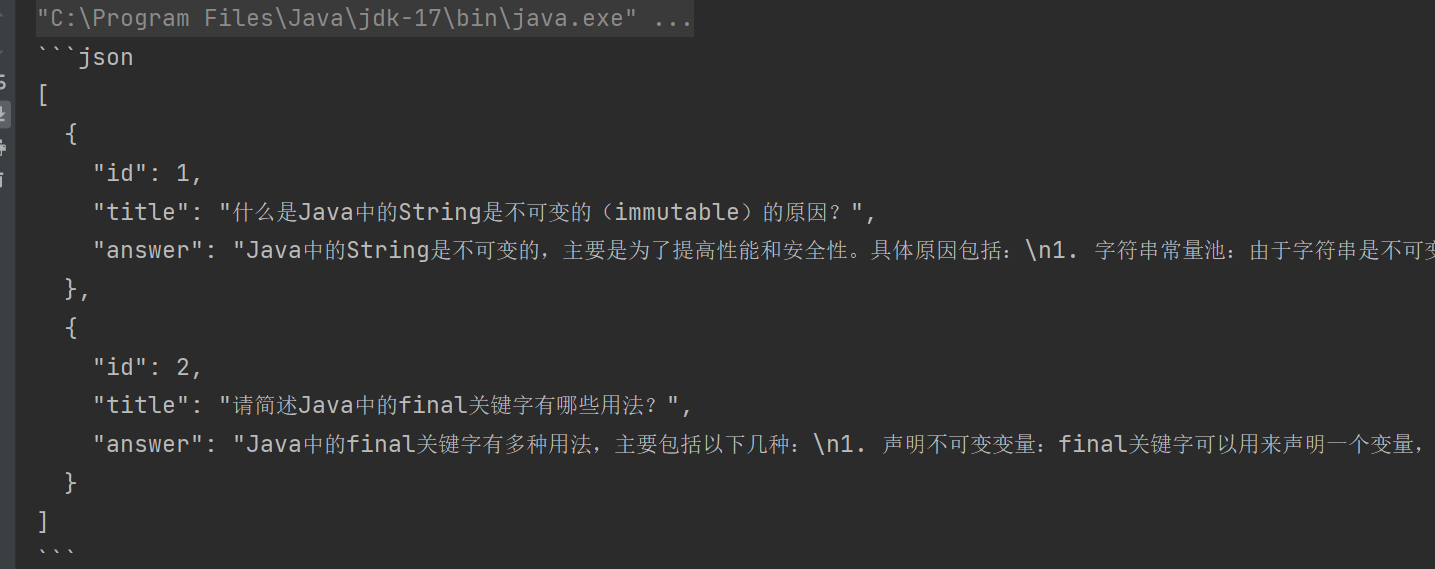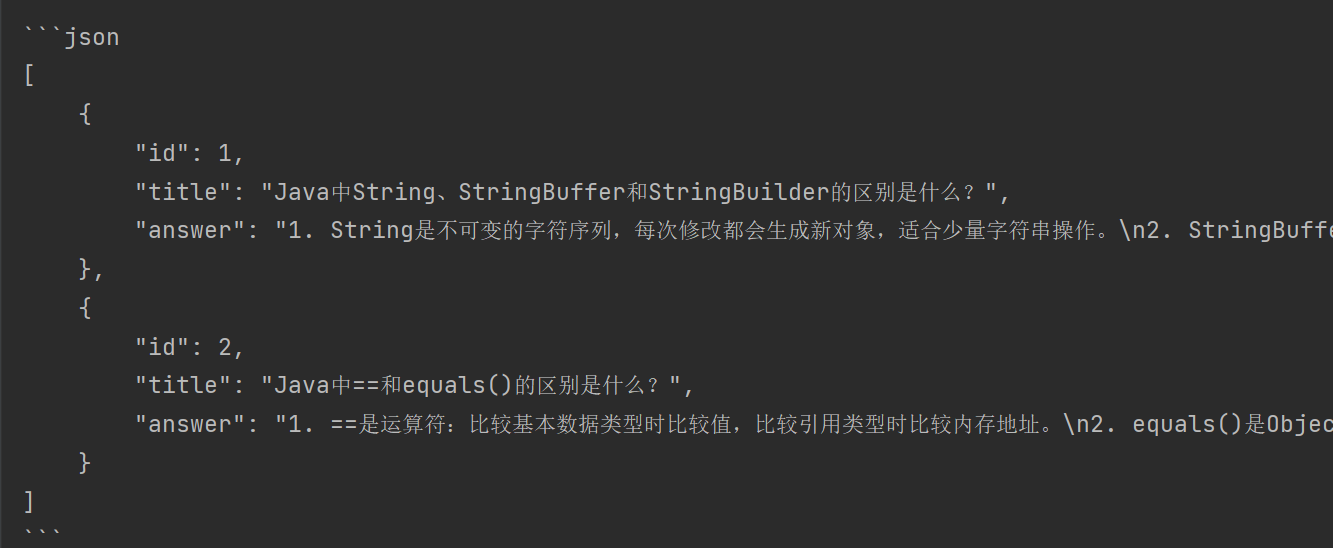很多大模型都支持对输出的内容进行格式化,通常情况下,一般将输出内容格式化为json数据,方便进行对象的转换。
LangChain4j中集成了对某些LLM格式化输出的支持,根据官网说明,暂时只对Azure OpenAI、OpenAI、Google AI Gemini、Ollama提供支持。
LangChain4j中是通过设置JSON Schema实现对JSON格式化输出处理,其中涉及的对象包括:
JsonObjectSchema:针对Object类型,转换为{}JsonStringSchema:针对字符串、字符类型JsonIntegerSchema:针对int、Integer、long、Long、BigInteger等类型JsonNumberSchema:针对float、Float、double、Double、BigDecimal等类型JsonBooleanSchema:针对boolean、Boolean类型JsonEnumSchema:针对枚举类型JsonArraySchema:针对数组、集合等类型,转换为[]JsonReferenceSchema:针对对象中出现递归的情况,比如Person类中包含一个List<Person>属性的情况JsonAnyOfSchema:提供对多态的对象的支持
但是,不同的模型对JSON Schema的支持也不一样,比如OpenAI仅支持rootElement为JsonObjectSchema,而Gemini还支持JsonArraySchema、JsonEnumSchema。所以在集成不同的模型时,需要查看模型的官网中对响应参数格式的要求。
本文仅测试了智谱的GLM-4-FLASH、通过OpenAI访问DeepSeekAPI、通过Ollama调用私有化部署的DeepSeek。
先说下根据测试的结果得出的个人见解吧,很多大模型对输出格式化的参数要求都不一样,直接使用JSON Schema相对复杂,直接在prompt中要求大模型返回指定json格式的数据其实更简单。
测试GLM-4-FLASH的输出格式化
通过大模型给出Java面试题,并格式化为json格式输出,数据中包含面试题的id、标题title、答案answer。
package com.renr.langchain4jnew.app;
import com.renr.langchain4jnew.constant.CommonConstants;
import dev.langchain4j.community.model.zhipu.ZhipuAiChatModel;
import dev.langchain4j.data.message.UserMessage;
import dev.langchain4j.model.chat.request.ChatRequest;
import dev.langchain4j.model.chat.request.ResponseFormat;
import dev.langchain4j.model.chat.request.ResponseFormatType;
import dev.langchain4j.model.chat.request.json.*;
import dev.langchain4j.model.chat.response.ChatResponse;
import java.time.Duration;
/**
* @Title: 返回格式化信息
* @Author 老任与码
* @Date 2025-04-09 11:05
*/
public class App11 {
public static void main(String[] args) {
// GLM-4-Flash不支持设置响应为json格式
ZhipuAiChatModel chatModel = ZhipuAiChatModel.builder()
// 模型key
.apiKey(CommonConstants.API_KEY)
// 精确度
.temperature(0.9)
.model("GLM-4-Flash")
.maxRetries(3)
.callTimeout(Duration.ofSeconds(60))
.connectTimeout(Duration.ofSeconds(60))
.writeTimeout(Duration.ofSeconds(60))
.readTimeout(Duration.ofSeconds(60))
.build();
// 设置每个元素的说明
JsonSchemaElement idSchema = JsonIntegerSchema.builder()
.description("面试题的id")
.build();
JsonSchemaElement titleSchema = JsonStringSchema.builder()
.description("面试题的标题")
.build();
JsonSchemaElement answerSchema = JsonStringSchema.builder()
.description("面试题的答案")
.build();
// 设置格式为json对象包含的属性
JsonSchemaElement rootElement = JsonObjectSchema.builder()
.addProperty("id", idSchema)
.addProperty("title", titleSchema)
.addProperty("answer", answerSchema)
.required("id", "title", "answer")
.build();
// 设置格式化为数组时,数组中元素的类型
JsonSchemaElement rootElement2 = JsonArraySchema.builder()
.description("面试题信息")
.items(rootElement)
.build();
// 设置响应格式
ResponseFormat responseFormat = ResponseFormat.builder()
.type(ResponseFormatType.JSON) // type can be either TEXT (default) or JSON
.jsonSchema(JsonSchema.builder()
.name("Subject")
.rootElement(rootElement)
.build())
.build();
UserMessage userMessage = UserMessage.from("请随机生成2道java基础的面试题,要求返回面试题的题号、题目和答案");
// 聊天时的请求对象
ChatRequest chatRequest = ChatRequest.builder()
// 设置响应格式
.responseFormat(responseFormat)
.messages(userMessage)
.build();
// 聊天的响应对象
ChatResponse chatResponse = chatModel.chat(chatRequest);
String output = chatResponse.aiMessage().text();
System.out.println(output);
}
}
输出

通过输出可以看到,GLM-4-Flash不支持JSON Schema指定的JSON格式。上文我们其实也提到了,LangChain4j没有提供对智谱大模型的格式化输出的支持。
但是我们可以直接要求其返回json格式:
package com.renr.langchain4jnew.app;
import com.renr.langchain4jnew.constant.CommonConstants;
import dev.langchain4j.community.model.zhipu.ZhipuAiChatModel;
import dev.langchain4j.data.message.UserMessage;
import dev.langchain4j.model.chat.request.ChatRequest;
import dev.langchain4j.model.chat.request.ResponseFormat;
import dev.langchain4j.model.chat.request.ResponseFormatType;
import dev.langchain4j.model.chat.request.json.*;
import dev.langchain4j.model.chat.response.ChatResponse;
import java.time.Duration;
/**
* @Title: 返回格式化信息
* @Author 老任与码
* @Date 2025-04-09 11:05
*/
public class App11 {
public static void main(String[] args) {
// GLM-4-Flash不支持设置响应为json格式
ZhipuAiChatModel chatModel = ZhipuAiChatModel.builder()
// 模型key
.apiKey(CommonConstants.API_KEY)
// 精确度
.temperature(0.9)
.model("GLM-4-Flash")
.maxRetries(3)
.callTimeout(Duration.ofSeconds(60))
.connectTimeout(Duration.ofSeconds(60))
.writeTimeout(Duration.ofSeconds(60))
.readTimeout(Duration.ofSeconds(60))
.build();
// UserMessage userMessage = UserMessage.from("请随机生成2道java基础的面试题,要求返回面试题的题号、题目和答案");
// 给出详细的prompt
UserMessage userMessage = UserMessage.from("请随机生成2道java基础的面试题,要求返回JSON格式数据,包括面试题的题号id、题目title和答案answer,参考JSON格式如下:[{id:1, title:xxx, answer:xxx}]");
// 聊天时的请求对象
ChatRequest chatRequest = ChatRequest.builder()
// 设置响应格式
// .responseFormat(responseFormat)
.messages(userMessage)
.build();
// 聊天的响应对象
ChatResponse chatResponse = chatModel.chat(chatRequest);
String output = chatResponse.aiMessage().text();
System.out.println(output);
}
}
输出内容如下:

使用这种方式,需要我们对返回的json数据进行额外处理,比如需要手动去除起始位置的'''json和结束位置的'''。
测试通过OpenAI调用DeepSeekAPI
package com.renr.langchain4jnew.app;
import com.renr.langchain4jnew.constant.CommonConstants;
import dev.langchain4j.data.message.UserMessage;
import dev.langchain4j.model.chat.ChatLanguageModel;
import dev.langchain4j.model.chat.request.ChatRequest;
import dev.langchain4j.model.chat.request.ResponseFormat;
import dev.langchain4j.model.chat.request.ResponseFormatType;
import dev.langchain4j.model.chat.request.json.*;
import dev.langchain4j.model.chat.response.ChatResponse;
import dev.langchain4j.model.openai.OpenAiChatModel;
/**
* @Title: 返回格式化信息
* @Author 老任与码
* @Date 2025-04-09 11:05
*/
public class App11_2 {
public static void main(String[] args) {
// OpenAi 只支持JsonObjectSchema
ChatLanguageModel chatModel = OpenAiChatModel.builder()
// deepseek的api的访问路径
.baseUrl("https://api.deepseek.com")
.apiKey(CommonConstants.DP_API_KEY)
// 模型名称
.modelName("deepseek-chat")
// .modelName("deepseek-reasoner")
// 请求的日志
.logRequests(true)
// 响应数据的日志
.logResponses(true)
.build();
JsonSchemaElement idSchema = JsonIntegerSchema.builder()
.description("面试题的id")
.build();
JsonSchemaElement titleSchema = JsonStringSchema.builder()
.description("面试题的标题")
.build();
JsonSchemaElement answerSchema = JsonStringSchema.builder()
.description("面试题的答案")
.build();
JsonSchemaElement rootElement = JsonObjectSchema.builder()
.addProperty("id", idSchema)
.addProperty("title", titleSchema)
.addProperty("answer", answerSchema)
.required("id", "title", "answer")
.build();
JsonSchemaElement rootElement2 = JsonArraySchema.builder()
.description("面试题信息")
.items(rootElement)
.build();
JsonSchemaElement rootElement3 = JsonObjectSchema.builder()
.description("面试题信息")
.addProperty("info", rootElement2)
.required("info")
.build();
ResponseFormat responseFormat = ResponseFormat.builder()
.type(ResponseFormatType.JSON) // type can be either TEXT (default) or JSON
// .jsonSchema(JsonSchema.builder()
// .name("Subject")
// .rootElement(rootElement3)
// .build())
.build();
UserMessage userMessage = UserMessage.from("请随机生成2道java基础的面试题,要求返回面试题的题号、题目和答案");
ChatRequest chatRequest = ChatRequest.builder()
.responseFormat(responseFormat)
.messages(userMessage)
.build();
ChatResponse chatResponse = chatModel.chat(chatRequest);
String output = chatResponse.aiMessage().text();
System.out.println(output);
}
}
OpenAI只支持JsonObjectSchema,所以我们额外增加了rootElement3对象,但是DeepSeek不支持jsonSchema的设置(执行会报错),于是我们注释掉如下代码:

执行上面代码后,依旧报错:

查看DeepSeek的帮助文档,其中提到:
 于是修改prompt如下:
于是修改prompt如下:
UserMessage userMessage = UserMessage.from("请随机生成2道java基础的面试题,要求返回JSON格式数据,包括面试题的题号id、题目title和答案answer,参考JSON格式如下:[{id:1, title:xxx, answer:xxx}]");
输出如下:

格式和我们要求的并不一样。
再次修改,将如下代码注释掉后进行测试:

输出结果如下:

对比看,不在请求中指定输出json格式后,返回的数据反而更好处理。
测试Ollama调用本地化部署的DeepSeek
关于DeepSeek的本地化部署,可以参考:DeepSeek本地化部署-优快云博客
package com.renr.langchain4jnew.app;
import dev.langchain4j.data.message.UserMessage;
import dev.langchain4j.model.chat.request.ChatRequest;
import dev.langchain4j.model.chat.request.ResponseFormat;
import dev.langchain4j.model.chat.request.ResponseFormatType;
import dev.langchain4j.model.chat.request.json.*;
import dev.langchain4j.model.chat.response.ChatResponse;
import dev.langchain4j.model.ollama.OllamaChatModel;
import java.time.Duration;
/**
* @Title: 返回格式化信息
* @Author 老任与码
* @Date 2025-04-09 11:05
*/
public class App11_3 {
public static void main(String[] args) {
OllamaChatModel chatModel = OllamaChatModel.builder()
.baseUrl("http://localhost:11434")
.modelName("deepseek-r1:1.5b")
.timeout(Duration.ofSeconds(100))
.temperature(1.3)
.logRequests(true)
.logResponses(true)
.build();
JsonSchemaElement idSchema = JsonIntegerSchema.builder()
.description("面试题的id")
.build();
JsonSchemaElement titleSchema = JsonStringSchema.builder()
.description("面试题的标题")
.build();
JsonSchemaElement answerSchema = JsonStringSchema.builder()
.description("面试题的答案")
.build();
JsonSchemaElement rootElement = JsonObjectSchema.builder()
.addProperty("id", idSchema)
.addProperty("title", titleSchema)
.addProperty("answer", answerSchema)
.required("id", "title", "answer")
.build();
JsonSchemaElement rootElement2 = JsonArraySchema.builder()
.description("面试题信息")
.items(rootElement)
.build();
JsonSchemaElement rootElement3 = JsonObjectSchema.builder()
.description("面试题信息")
.addProperty("info", rootElement2)
.required("info")
.build();
ResponseFormat responseFormat = ResponseFormat.builder()
.type(ResponseFormatType.JSON)
.jsonSchema(JsonSchema.builder()
.name("Subject")
.rootElement(rootElement3)
.build())
.build();
UserMessage userMessage = UserMessage.from("请随机生成2道java基础的面试题,要求返回面试题的题号、题目和答案");
ChatRequest chatRequest = ChatRequest.builder()
.responseFormat(responseFormat)
.messages(userMessage)
.build();
ChatResponse chatResponse = chatModel.chat(chatRequest);
String output = chatResponse.aiMessage().text();
System.out.println(output);
}
}
输出结果:
{
"info": [{
"id": 50,
"title": "What is Java? Please write a short answer.",
"answer": "Java is an object-oriented programming language that allows objects to be used in place of data types like String and int. It's known for its support of generics and extensibility."
}, {
"id": 48,
"title": "Implementing a Linked List in Java...",
"answer": "To implement a linked list in Java, we can create a class with nodes that hold integer data values. Each node will have pointers to the previous and next nodes."
}]
}
通过输出可以看到,返回的数据可以直接用于转换Java对象,不需要再进行额外处理。
结论
由于LangChain4j在格式化输出上,支持的大模型有限。笔者建议,如果需要返回json格式的数据,在prompt中直接指定格式更直接、更好处理。






















 473
473

 被折叠的 条评论
为什么被折叠?
被折叠的 条评论
为什么被折叠?








